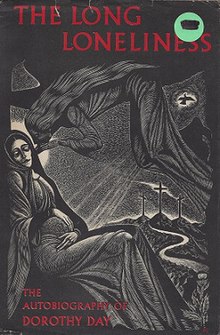The Long Loneliness

The Long Loneliness is the autobiography of Dorothy Day, published in 1952 by Harper & Brothers. In the book, Day chronicles her involvement in socialist groups along with her eventual conversion to Catholicism in 1927, and the beginning of her newspaper the Catholic Worker in 1933.[1][2]
It has been characterized as "a remarkably candid account, without piety, of her journey to faith".[1] A 1952 review in the New York Times focused on her interactions with communism and her journey away from it while staying true to her radical roots: "This book will not shock anybody. It may touch many, whatever their secular or religious faith, who lament the kindliness and sympathy that Communists found among certain left-wing groups -- and betrayed."[2]
List of people and publications[]
The following is a list of prayers, people, and publications mentioned in the book until the end of the chapter "The Masses":
Prayers[]
People[]
- Augustine of Hippo (St. Augustine)
- Peter Maurin
- Fred Ellis (cartoonist)
- Francis de Sales (St. Francis de Sales)
- G. K. Chesterton
- Mary Harrington
- Mrs. Barrett
- Virgil (Vergil)
- Xenophon
- Alfred, Lord Tennyson
- Fyodor Dostoevsky (Dostoevski)
- Carl Sandburg
- Eugene V. Debs
- Jack London
- Upton Sinclair
- Frank Harris
- Peter Kropotkin
- Vera Figner
- Karl Marx
- Maxim Gorky (Gorki)
- Leo Tolstoy (Tolstoi)
- Jesus
- Rayna Prohme (Rayna Simons)
- Vincent Sheean
- Samson Raphaelson (Raph)
- Rose Pastor Stokes
- Scott Nearing
- John Masefield
- Edgar Lee Masters
- Charles Baudelaire
- Francesc Ferrer i Guàrdia (Francisco Ferrer)
- William Godwin
- Pierre-Joseph Proudhon
- Eric Gill
- Vincent McNabb
- Hilaire Belloc
- Emma Goldman
- Alexander Berkman
- François Mauriac
- Hypolite Havel
- Robert Minor
- Charles Ashleigh
- Leon Trotsky
- Ludwig Lore
- Elizabeth Gurley Flynn
- Max Eastman
- Floyd Dell
- Merrill Rogers
- John Reed (journalist) (Jack Reed)
- Arturo Giovannitti
- Art Young
- Hugo Gellert
- Boardman Robinson
- Maurice Becker
- Henry Glintencamp
- Mike Gold
- Edna Kenton
- David Karb
- Brian Oswald Donn-Byrne (Donn Byrne)
- Hi Moderwell
Publications[]
- Demons (Dostoevsky novel) (The Possessed)
- Daily Worker
- Ecclesiastes
- Bible
- Psalms
- The Saturday Evening Post
- Science and Health with Key to the Scriptures
- Chicago Inter Ocean
- Georgics
- Eclogues (Bucolics)
- The Day Book
- Martin Eden
- The Jungle
- The Mystery of Love by Upton Sinclair
- Personal History by Vincent Sheean
- Tommy and Grizel by J. M. Barrie
- The Morning Telegraph
- New York Call
- The Harbor by Ernest Poole
- Industrial Worker
- Fields, Factories and Workshops
- Mutual Aid: A Factor of Evolution
- The Conquest of Bread
- The Philosophy of Poverty by Pierre-Joseph Proudhon
- The Poverty of Philosophy
- The Un-Marxian Socialist by Henri de Lubac
- What Is Property?
- Memoirs of a Revolutionist
- The Atlantic (Atlantic Monthly)
- Mother Earth (magazine)
- Living My Life
- Rerum Novarum
- Novy Mir (1916 magazine)
- Leipziger Volkszeitung
- The Masses
- Pearson's Magazine
- Ten Days That Shook the World
References[]
- ^ a b McCarraher, Gene (June 27, 2004). "'The Long Loneliness' at 50". Commonweal Magazine (May 3, 2002). Retrieved February 6, 2022.
- ^ a b Duffus, R.L. (January 20, 1952). "Behind the Slogans She Saw the Dream in Men's Hearts; THE LONG LONELINESS. The autobiography of Dorothy Day". New York Times. Retrieved February 6, 2022.
External links[]
- Political autobiographies
- 1952 non-fiction books
- Catholic Worker Movement
- Harper & Brothers books
- Dorothy Day
- Catholic Church stubs
- Religious people book stubs
- Christian studies book stubs